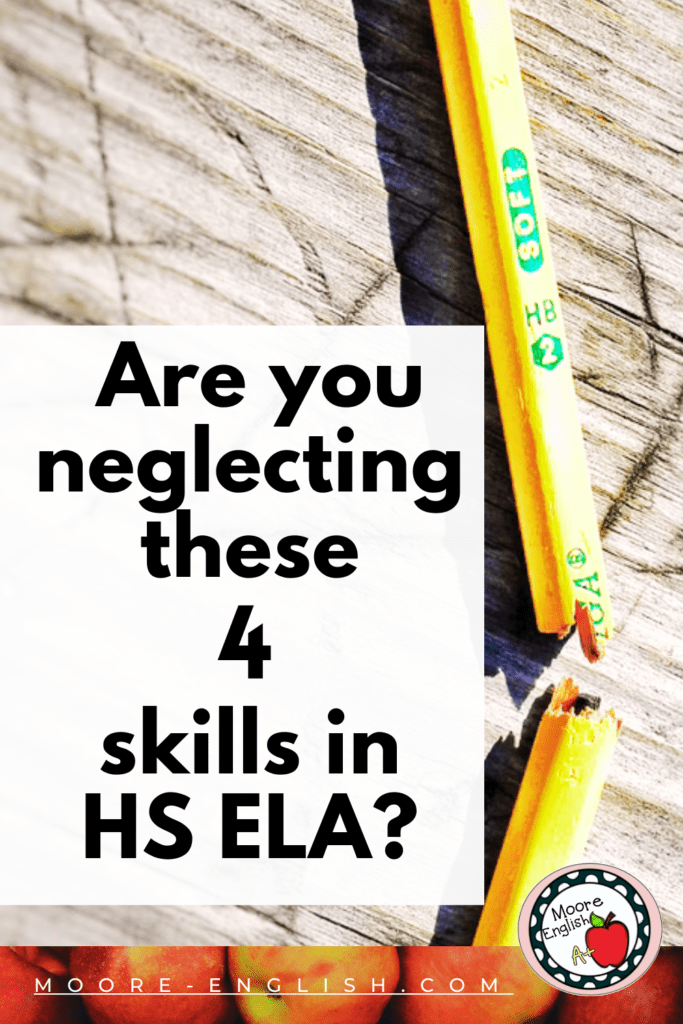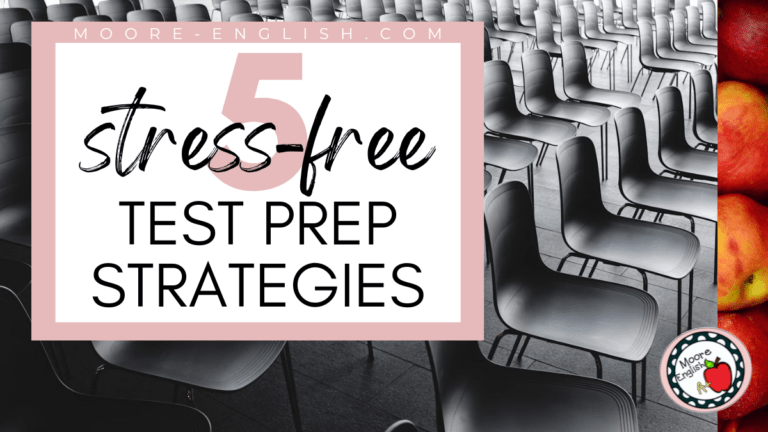In the past, I’ve neglected certain parts of ELA. Some skills I blew off. Others made me uncomfortable. And others I expected students to have before they arrived in my classroom.
None of these are good reasons to write off academic skills. More than anything, these attitudes put my students at a disadvantage. Similarly, these attitudes also prevented me from making professional growth.
But I’ve learned to never say never in education.
And I’m hope that by sharing my mistakes, others can learn what NOT to overlook or neglect in ELA instruction.
This post this post may contain affiliate links. Please read the Terms of Use.
Stop Neglecting Text Features
Especially as a younger teacher, I blew off text features. In part, I didn’t pay enough attention to text features in my own reading. However, text features are often an important part of a text, especially when they help students make sense of a larger work. Authors include text features for a reason, so ignoring text features provides readers with an incomplete view of the text. Here are a few ways that I stopped neglecting text features in my 9-12 instruction:
- First, I made circling text features a key step in pre-reading nonfiction texts.
- At the same time, I started designing classroom resources with rich text features. In particular, I got good at asking students questions that required them to consider key text features.
- Additionally, I started challenging students to include text features in their own writing. My students, especially those who enjoy creative pursuits, usually enjoy creating their own charts, infographics, diagrams, etc. My visual learners often value incorporating bulleted lists.
- Finally, I created a fun Text Features Concentration for when students need intervention or direct instruction about types of text features.
Neglected Skill #2: Making Meaningful Inferences
Similarly, I have often been guilty of neglecting teaching inference. In the past, I have assumed that students arrived in ninth grade with the ability to make inferences. However, like most skills, making meaningful inferences requires constant practice. More importantly, I also learned that students are sometimes happy to make an easy if not especially insightful inference. For this reason, it’s important for teachers to constantly push students toward making more nuanced inferences.
Here are some ways I stopped neglecting inference as a skill:
- First, I made inferences a significant part of my yearly pre-assessment. This gives me a baseline for students. Then, I make sure there is a least one inference question on every. single. formative. assessment. This isn’t especially difficult to do since comprehending most any text requires students to make inferences.
- Additionally, during one of our first classroom whole group guided readings, I ask students to explicitly define inference. By doing this as a whole group, I help all students develop a common vocabulary. Sometimes we even make an anchor chart with the definition of inference on it so we can revisit it throughout the year.
- Finally, I put together a collection of 10 interesting poems that require students to make significant inferences. I draw on these poems when students need additional practice with making inferences. Sometimes that’s whole group practice, but more often than not it’s small group reteaching or intervention. Grab all 10 poems for making inferences!
Stop Neglecting Context-Clues Strategies
As with making inferences, I often assumed that students arrived with their context-clues strategies fully formed and ready to use. As I’ve discussed before, that is not the case. Instead, I learned that students knew the words “context clues” without being able to point to specific words or phrases that give readers insight into the meaning of unknown words. To stop neglecting these skills, I took a series of careful steps:
- As with inferences, I made sure that context-clues questions were on my pre-assessment.
- Similarly, I started spiraling context-clues skills into every unit. I have context clues questions ready to go for To Kill a Mockingbird, Things Fall Apart, and Shakespeare.
- I also started teaching the lesson described in this post. This is a lesson I teach to pretty much every class. This is another good way to build common classroom vocabulary.
- Finally, I put together a series of 12 poems designed to target a variety of vocabulary skills. Sometimes I draw on these poems to teach a specific vocabulary skill like using context clues or evaluating connotative meaning. Other times, I use these poems for targeted intervention. Grab all 12 poems today!
Neglected Skill #4: Analyzing Poetic Meter
Neglecting inferences and context clues came from a belief that students already had these skills. Neglecting poetic meter was another matter entirely. Until recently, I neglected teaching meter because I was certain students didn’t know anything about it. I wasn’t convinced students would ever need to know about meter. Plus, I didn’t feel at all confident in my own ability to determine poetic meter (after all, somewhere along the line that had been a neglected part of my education.)
In the end, I became convinced that analyzing poetry requires at least a cursory understanding of poetic meter. No, I do not think students need to understand the elaborate vocabulary related to poetic meter (and I don’t teach that at all). However, I do think that being able to identify changes in meter helps students understand poetic structure. When the meter changes, the author is signaling something. Being able to identify that something is part of being able to really analyze a poem! Here are some of the steps that helped me stop neglecting meter:
- Unlike earlier skills, I do not incorporate meter on my pre-assessment. I don’t need anyone to tell me that my incoming students have no idea what meter is.
- First, I help students get comfortable with poetry by using these 4 pre-reading steps.
- Then, I scaffold poetry instruction intentionally. I make careful choices about which poems I will teach when and in what order. You might think that I would save meter for the end of the instructional spiral, but I actually introduce meter pretty early on.
- Next, I write formative assessment questions that ask students to grapple with meter. Where did the meter change? Why did the author make that change? The altered meter in this section causes which reaction? How does the changing meter suit the author’s purpose?
- Finally, I spiral meter throughout our poetry study.
Last Thoughts
At the end of the day, there is no way a teacher can perfectly hit every single standard or skill. Some classes need to spend extra time in certain units of study and that means they will spend less time elsewhere. Similarly, the schedule of a school means that some lessons are interrupted. Plus, you know, our current students are all learning during a pandemic. However, being mindful of these 4 skills can help teachers make sure they are not neglecting some key parts of high school ELA.


Photo by Caleb Woods, Jess Bailey, Joshua Hoehne, Mike Walter, Alexandra Gorn on Unsplash













